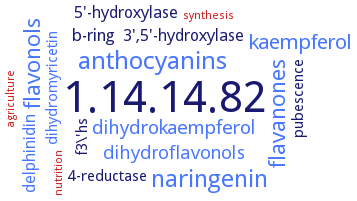1.14.14.82: flavonoid 3'-monooxygenase
This is an abbreviated version!
For detailed information about flavonoid 3'-monooxygenase, go to the full flat file.

Word Map on EC 1.14.14.82 
-
1.14.14.82
-
anthocyanins
-
naringenin
-
flavanones
-
flavonols
-
kaempferol
-
dihydrokaempferol
-
dihydroflavonols
-
b-ring
-
delphinidin
-
3',5'-hydroxylase
-
5'-hydroxylase
-
4-reductase
-
f3\'hs
-
pubescence
-
dihydromyricetin
-
nutrition
-
synthesis
-
agriculture
- 1.14.14.82
- anthocyanins
- naringenin
- flavanones
- flavonols
- kaempferol
- dihydrokaempferol
- dihydroflavonols
-
b-ring
- delphinidin
-
3',5'-hydroxylase
-
5'-hydroxylase
-
4-reductase
-
f3\'hs
-
pubescence
- dihydromyricetin
- nutrition
- synthesis
- agriculture
Reaction
Synonyms
CsF3'H, Cyp75B, CYP75B1, CYP75B3, CYP75B4, CYP75B50, EC 1.14.13.21, F3'H, flavonoid 3'-hydroxylase, flavonoid 3-hydroxylase, flavonoid 3�-hydroxylase, More, NADPH:flavonoid-3'-hydroxylase, oxygenase, flavonoid 3'-mono-, oxygenase, flavonoid 3-mono-, PR1, sb04g024710, SF3'H1
ECTree
Advanced search results
Application
Application on EC 1.14.14.82 - flavonoid 3'-monooxygenase
Please wait a moment until all data is loaded. This message will disappear when all data is loaded.
agriculture
enzyme expression is under control of pericarp color1, P1. The P1 controlled 3-deoxyanthocyanidin and C-glycosyl flavone defence compounds accumulate at significantly higher levels in Pr1 silks as compared to pr1 silks. By virtue of increased maysin synthesis in Pr1 plants, corn ear worm larvae fed on Pr1/P1 silks show slower growth as compared to pr1/P1 silks
nutrition
the enzyme may be a good candidate for biotechnological applications aimed at obtaining new flower colours or at increasing the production of compounds important both for the physiology of the plant and for the promotion of human health
synthesis
-
functional expression in Saccharomyces cerevisiae, to hydroxylate naringenin in whole recombinant cells. In a selective media, 200 mg/l of eriodictyol from naringenin can be produced
additional information
understanding the regulation of flavonoid hydroxylases could be used to modify flavonoid composition of fruits


 results (
results ( results (
results ( top
top






